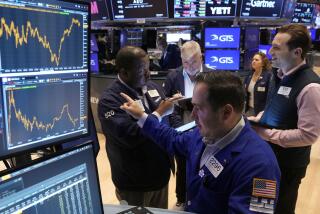Stocks Rally on Rate Hopes
- Share via
Stocks kicked off the new year with a powerful advance Tuesday, after the minutes of the last Federal Reserve meeting reinforced the idea that the central bank was nearly done tightening credit.
The Dow Jones industrial average jumped 129.91 points, or 1.2%, to 10,847.41, the biggest one-day gain since Oct. 28. The New York Stock Exchange composite index hit a record high, a sign of broad demand for shares.
The Mexican and Brazilian markets also hit all-time highs on expectations that those emerging economies would benefit from a leveling-off of U.S. interest rates. But a surge in the price of gold was a reminder that some investors remain jittery about stocks and bonds and are betting elsewhere this year.
Wall Street, which was unable to pull off its traditional year-end rally last week, was drifting aimlessly Tuesday until the Fed at midday released the minutes of its Dec. 13 meeting.
The tone of the meeting summary was that policymakers expected that they wouldn’t have to raise their benchmark short-term interest rate much further.
A key passage from the minutes said that most Fed members believed that, “given the information now in hand, the number of additional firming steps required probably would not be large.”
Many investors have been assuming as much since the Fed on Dec. 13 raised its key rate from 4% to 4.25%, the 13th consecutive increase since mid-2004, but also changed its official post-meeting statement to hint that it might be almost finished.
Still, the meeting minutes were like a shot of adrenaline for stocks. The market zoomed immediately after the Fed summary was released.
Wall Street’s response was a reminder that, “if you reduce the uncertainty about Fed policy, this market wants to go higher,” said Subodh Kumar, investment strategist at CIBC World Markets in New York.
Like the Dow, the Standard & Poor’s 500 index scored its biggest jump since Oct. 28, rising 20.51 points, or 1.6%, to 1,268.80.
The technology-heavy Nasdaq composite index rallied 38.42 points, or 1.7%, to 2,243.74, its largest gain since July 8.
Winners outnumbered losers by about 3 to 1 on the NYSE and by about 3 to 2 on Nasdaq, in heavy trading.
The breadth of the advance pushed the NYSE composite index up 2% to a record 7,912.41, surpassing the previous peak of 7,852.18 set Dec. 14.
Analysts said the market’s lift-off suggested that some traders were hungry to get something going, after Wall Street stumbled in the final week of the year. The days between Christmas and New Year’s historically have been good for stocks, but the Dow sank 1.5% last week, and was down 0.6% for the year.
Todd Clark, head of stock trading at Nollenberger Capital Partners in San Francisco, said Tuesday’s rally was a sign that “there is a lot of fast money chasing [stocks],” hoping to create momentum.
With the S&P; 500 up a mere 3% last year, “You’re not getting any performance just [buying] the indexes,” he said.
But Clark worried that the same concerns that weighed on stocks last week -- that the U.S. economy might slow significantly in the first half of this year, and corporate profit growth with it -- soon could return.
Even if the Fed is done raising rates, the question for stocks is whether the central bank might already have tightened credit too much, analysts say.
A report Tuesday from the Institute for Supply Management showed that the U.S. manufacturing sector’s growth rate eased in December from November.
Separately, Wal-Mart Stores shares sank 57 cents to $46.23 after the retailer reported a disappointing gain in December sales.
An “inversion” of interest rates in the Treasury bond market last week -- with shorter-term rates rising above long-term rates for the first time since 2000 -- also hinted at a weaker economy ahead. Such inversions historically have signaled economic slowdowns or outright recessions, although many experts say they doubt the message is dire this time around.
On Tuesday, the Fed meeting minutes had a limited effect in the Treasury bond market. The two-year T-note yield fell to its lowest since Nov. 28, ending at 4.33%, down from 4.40% on Friday. But the 10-year T-note eased only modestly, to 4.36% from 4.39% on Friday.
In currency trading, however, the dollar tumbled against the yen and the euro as some traders figured the Fed might well be done raising rates. That could dim the dollar’s appeal.
Some investors and traders jumped back into gold, driving near-term futures contracts in New York up $13.60 to a 24-year high of $530.70 an ounce. Gold has benefited in recent months as more investors have sought a way to hedge against possible turmoil in the economy and in financial markets, analysts say.
Among the day’s highlights:
* The Fed meeting minutes helped push the Mexican and Brazilian stock markets to record highs, with both jumping more than 3%. The Fed, by winding down its campaign of interest rate hikes, could boost prospects for continued economic growth worldwide, which would aid developing countries.
* Interest-rate-sensitive shares, including banks and builders, were broadly higher. Banking firm Wachovia rallied $1.25 to $54.11. Home builder KB Home surged $3 to $75.66.
* Energy stocks again were out front as crude oil prices rose above $63 a barrel for the first time since October. Exxon Mobil gained $2.30 to $58.47; Schlumberger soared $6.21 to $103.36.
More to Read
Inside the business of entertainment
The Wide Shot brings you news, analysis and insights on everything from streaming wars to production — and what it all means for the future.
You may occasionally receive promotional content from the Los Angeles Times.










